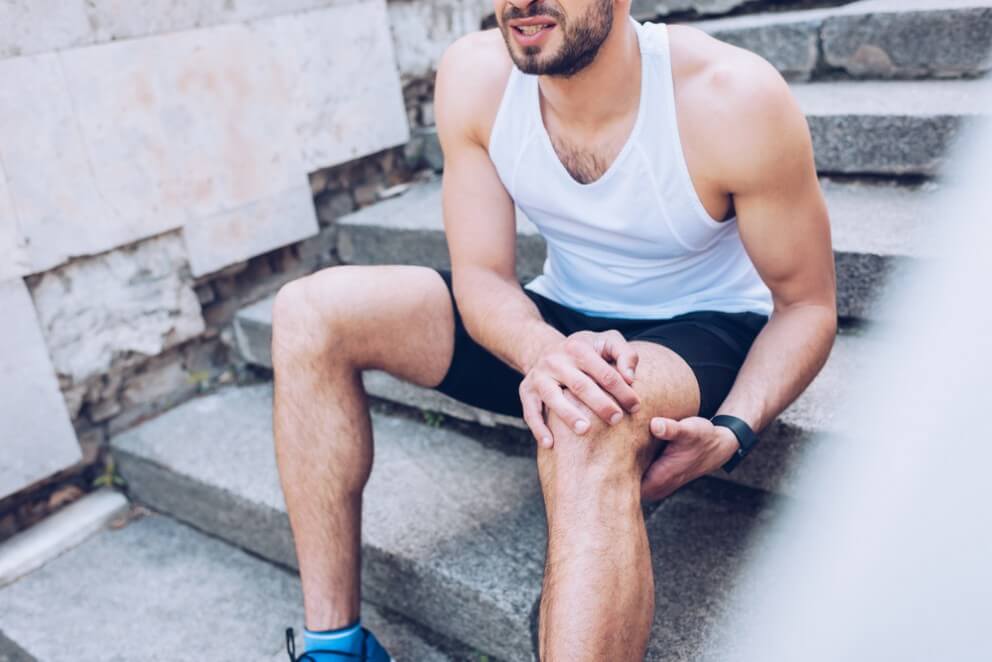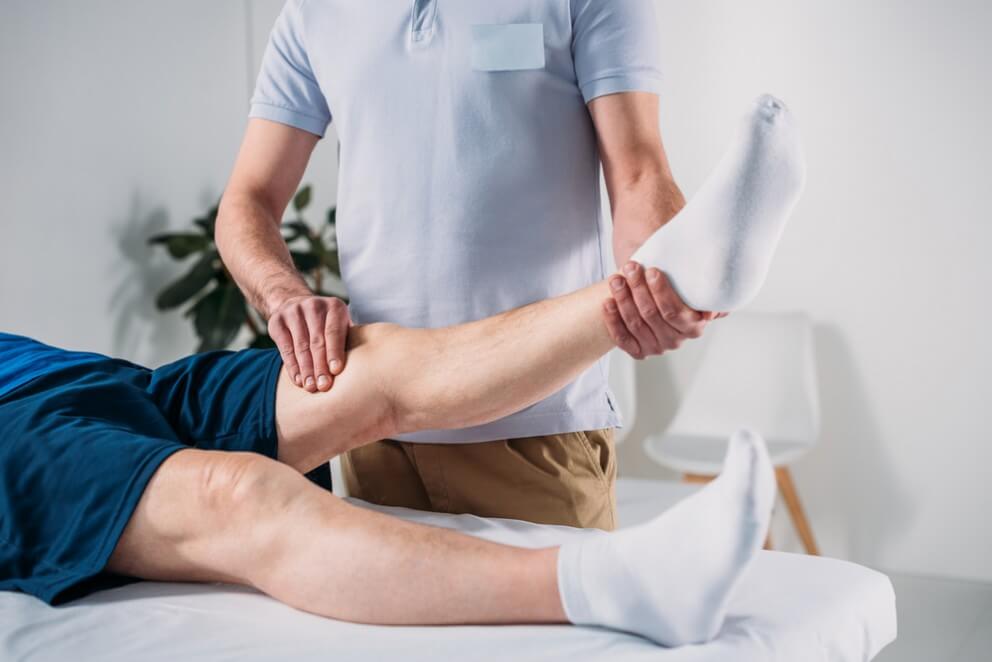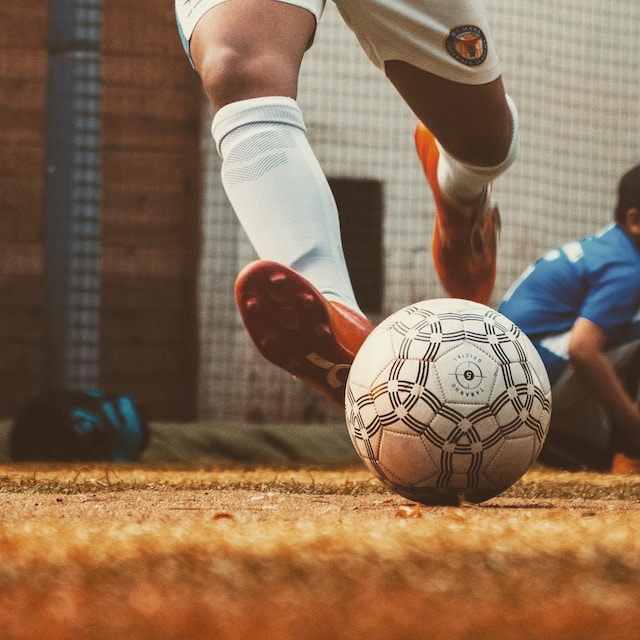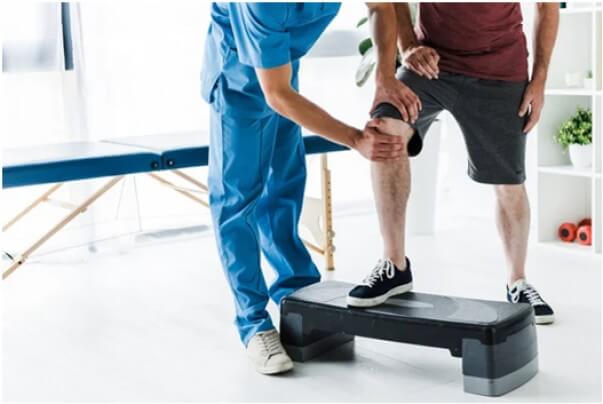What is holding you back from taking care of your knee pain?
Is it fear? Uncertainty?
Lack of knowledge?
Do you think this is good?
Obviously not.
But sometimes holding back is gold.
There are several structures in your knee joint that hold your bones back and these structures are called ligaments.
One important ligament of your knee joint is Posterior Cruciate Ligament (PCL) that holds your knee joint in place and does not let your shin bone go excessively backward. (1)

If it is injured, your knee joint gets a bit unstable.
Surgery is not always indicated and research shows that individualised rehabilitation programmes can help in fighting this injury without the need of surgery. (2)
The Importance of PCL Exercises for Mobility
If your PCL is injured, customised PCL rehab exercises can play a crucial role in the recovery process.
Your knee joint lies in between the hip and the ankle joint, and that’s why it needs stability more than any other joint in your body. (3)
Research shows that whenever a structure in our body is injured, our body responds by inhibiting the muscles around that area, in order to protect that area from further injury. (4)
In case of PCL injury, muscles around your knee joint may get inhibited.
Customised PCL rehab exercises help to activate those inhibited muscles around your knee joint and help to bring back the mobility, strength, flexibility and stability required in your knee joint.
Imagine an athlete who faced a PCL injury which has put him out of the field and he is now on bed rest.
He is not performing any PCL rehab exercises and his muscles are getting weaker day by day.
His mobility is restricted and the knee pain is limiting his activities.

If the athlete is not even mobile, how do you suppose that he is going to be in the field after a few weeks without even performing any of the customised PCL injury exercises?
Bespoke PCL rehab exercises are required for gaining the mobility of your knee joint following a PCL injury.
Why laser sharp customisation is absolutely crucial to address mobility?
One other thing that I want you to know is that not all PCL injuries are the same and that’s why not all PCL rehab exercises are recommended for each individual.
The exercises that you perform must be customised according to the:
- type of injury,
- compensatory mechanisms formed
- other types of imbalances already created,
- your activity levels and
- your desired goals.
How can generalised PCL rehab exercises of two persons be the same if one is a professional marathon runner while the other is an office worker?
Got my point?
I’m sure you did.
If your PCL (the ligament that was holding your knee joint is placed) is damaged, it’s time for you to take action.
You should not hold yourself back from taking an action that will benefit your injured PCL.
Why walk with fear when you can run with confidence?
If you have any questions, you can get them answered and that too for FREE.
Click here to book your FREE ONLINE CONSULTATION now.
The Importance of Exercises for Strength
Just like mobility, strength is vital for your quick recovery from PCL injury.
PCL rehab exercises not only target your mobility but also the strength of the muscles of your knee.
When PCL is injured and muscles get inhibited (due to your body’s response), the strength of the muscles also decreases.
Targeted PCL rehab exercises focus on building the strength of the muscles responsible for supporting your knee joint.
Are you looking for the best PCL injury rehab exercises known to boost your knee rehab recovery?
If the answer is yes, you must have found a countless number of PCL recovery exercises that left you confused on which exercises to do and which PCL injury exercises to avoid.
No worries, as a long-term personal trainer expert in PCL tear rehab exercises, I will brief you on how to safely and effectively do PCL injury rehab exercises without interrupting your PCL’s healing process.

The Best PCL Rehab Exercises for Pain-Free Knee Movement
To boost the healing process of your injured PCL, it is important to remember the most effective PCL strengthening exercises that engage the muscles around the knee without placing too much load on the knee joint itself. For example – some of these could be:
• Straight Leg Raises,
• Quarter squats and
• Knee flexion – heel slides.
It is also important to keep stretching the knee muscles to maintain tissue flexibility and range of motion. You can try stretch exercises like Calf stretch and Bent leg hamstring stretch.
If you are not sure when to start these exercises, and wondering when it is the safest to start, contact Jazz Alessi for a FREE CONSULTATION!
PCL Injury Exercises to Avoid
Some exercises can interrupt your knee healing process. Especially if done too early in the recovery journey. These exercises include deep squats, lunges, leg press, step ups in addition to high-impact weight bearing activities like jumping and running.

Imagine having a mobile knee joint but not enough strength to move it?
It’s of no use. Right?
That’s the reason why injury assessment based and carefully created customised PCL injury exercises for rehab are necessary for building strength of the muscles as well as ensuring the mobility.
Why laser sharp customisation is absolutely crucial to address strength?
No matter which musculoskeletal or neurological injury you are recovering from, injury rehab customisation is the most important thing.
Whenever you buy a pair of shoes, why do you select the shoes that match your foot size?
I know that’s a foolish question.
But when it comes to choosing PCL injury exercises for rehab, most of us forget this simple logic.
We start performing all of the strength exercises that we come across at the internet or books.
Most of the personal trainers and even some physios also make this common mistake while designing a rehab programme for PCL injury.
If you are a professional soccer player and had a PCL injury, you need a different level of strength in your knees as compared to a person who is a tennis player and suffered an ACL injury.
Similarly, the PCL injury exercises for rehab in both of these cases must be different and 100% customised to the player’s needs and body’s demands.

Now, you may be asking yourself why you didn’t ever come across such thought-provoking information before.
There’s much more.
You will be surprised to see how customised PCL rehabilitation programmes can boost your recovery.
You want to learn more. Don’t you?
Here’s the first online consultation for you to get a deeper insight into your PCL injury and its rehab.
Book your FREE ONLINE CONSULTATION now.
8 PCL Injury Exercises to Avoid
The most important things you should know during your rehabilitation are the things that you must avoid (or perform with caution).
This is again a major problem, especially in London.
The personal trainers and physios focus on various exercises for your PCL injury but no one bothers to inform you about the PCL injury exercise that you should avoid.
Worry not.
I’m here to fill this gap and guide you about those exercises and activities.
1. Avoid applying heat to your swollen knee as this may further exacerbate the swelling.
Icing is a preferred method to minimise the swelling. (5)
2. Avoid sitting for prolonged period with your knee in dependant position.
3. Avoid hyper-extension of your knee joint (especially during the first few weeks). (2)
When your knee is completely straight, we call it to be extended.
If the knee goes further forward, we call it to be hyper-extended.
4. Exercises that push your shin bone (tibia) in backward direction should be avoided in early weeks. (2)

5. Avoid full weight bearing on the affected knee joint (especially during first 1-2 weeks).
6. Do not perform knee range of motion exercises in supine lying (lying straight).
Prone lying position (lying on belly) is recommended in early stages of recovery. (6, 7)
7. Do not bend your knee beyond 90 degrees for the first 2 weeks. (6, 8)
8. Avoid wearing knee brace in advanced stages of rehabilitation (after 8-12 weeks). (9)
These are some of the golden tips but you need more than that to boost your recovery speed.
If you need more tips for your PCL knee injury, book your FREE ONLINE CONSULTATION now.
Conclusion
Jazz Alessi is a long term PCL exercise rehab specialist in London and his clients say that he is the best in this field.
PCL knee injury is a common injury that compromises your knee joint’s stability.
Surgery is not the only option for managing PCL knee injury.
Customised PCL rehabilitation programme offered by the best Elite Personal Trainer in East London not only paves your way towards smooth PCL injury recovery but also maximises your performance.
If you have knee pain or have any PCL injury symptoms (either acute or chronic), it’s time for you to take action and seek professional services for dealing with this injury.
Your knee joint is one of the most important joints in your body and that’s why you have to take this injury seriously.
To help you succeed in the journey of taking care of your body, join our PCL rehab programme that will be totally customised according to your preferences and your body’s needs.
What are you waiting for?
Book your FREE ONLINE CONSULTATION now directly with Jazz Alessi.
What is the fastest way to heal a PCL?
The fastest way to heal an injured PCL is to allow for uninterrupted healing. But this does not mean complete rest, it means completing a comprehensive assessment and based on this start early activities and performing only customised knee rehab exercises that are safe and that allow for your PCL to heal.
Which is the best exercise for PCL rehab?
There is no one exercise considered the best for PCL rehab, as the rehab journey consists of a comprehensive assessment first and this is followed by a customisation of strengthening and stretching exercises that are equally important to restore the knee function and to maintain balance around the knee joint.
Can you rehab a PCL tear?
If your PCL is partially torn, rehabilitation plays an inevitable role as the first line of treatment to restore your knee function and it cannot be substituted. However, if your PCL is completely torn like grade 3 tear, your doctor will recommend surgery with a strong post-surgical rehabilitation programme.
What exercise can I do with a torn PCL?
The exercises that you can do with a torn PCL vary based on where in the healing process you are, how severe your injury (ligament tear grade 1,2 or 3) is and what treatments are recommended by your rehab clinician. You might be asked to avoid certain exercises in the early stage and encouraged to do the same exercises later on. All depends on your assessment and knee condition.
How do PCL rehab exercises help with recovery?
PCL rehab exercises help you restore the range of motion, stability of your knee joint by improving muscle strength and flexibility.
It helps you restore your balance and proprioception that will prevent your knee from giving way after your injury heals.
Moreover, in a customised manner it prepares you to go back to your chosen activities and sports (a successful PCL rehabilitation preparing you to return to competitive rugby or football will be totally different for a PCL rehab to help you return to competitive tennis) in short time while ensuring complete safety.
Are there any exercises to avoid when rehabilitating a PCL injury?
You need to avoid exercises that may interrupt your healing process. Especially if done too early in the recovery journey. for instance, deep squats, lunges and leg presses and all the exercises that your rehab professional advised against using them.
Can PCL rehab exercises be done without a personal trainer?
You can find resources over the internet on what to do after PCL injury. However, because every person is unique and you might be one repetition away from aggravating your PCL injury (most of the time this is what it takes to cause an injury – one more repetition), it is best to work out under the supervision of an expert PCL personal trainer to ensure safety and effectiveness of your rehab.
REFERENCES
1. Amis A, Gupte C, Bull A, Edwards A. Anatomy of the posterior cruciate ligament and the meniscofemoral ligaments. Knee Surgery, Sports Traumatology, Arthroscopy. 2006;14(3):257-63.
https://pubmed.ncbi.nlm.nih.gov/16228178/
2. Wang D, Graziano J, Williams RJ, Jones KJ. Nonoperative treatment of PCL injuries: goals of rehabilitation and the natural history of conservative care. Current reviews in musculoskeletal medicine. 2018;11(2):290-7.
https://pubmed.ncbi.nlm.nih.gov/29721691/
3. Snell RS. Clinical anatomy by regions: Lippincott Williams & Wilkins; 2011.
https://medicostimes.com/snells-clinical-anatomy-9th-edition-pdf/
4. Rice DA, McNair PJ, editors. Quadriceps arthrogenic muscle inhibition: neural mechanisms and treatment perspectives. Seminars in arthritis and rheumatism; 2010: Elsevier.
https://pubmed.ncbi.nlm.nih.gov/19954822/
5. Weber K. The technical benefits of icing. Moji; 2009.
https://inversemed.com/wp-content/uploads/The-Technical-Benefits-of-Icing.pdf
6. Grood ES, Stowers SF, Noyes FR. Limits of movement in the human knee. Effect of sectioning the posterior cruciate ligament and posterolateral structures. Jbjs. 1988;70(1):88-97.
https://pubmed.ncbi.nlm.nih.gov/3335577/
7. Veltri DM, Warren RF. Isolated and combined posterior cruciate ligament injuries. JAAOS-Journal of the American Academy of Orthopaedic Surgeons. 1993;1(2):67-75.
https://pubmed.ncbi.nlm.nih.gov/10675857/
8. Pierce CM, O’Brien L, Griffin LW, LaPrade RF. Posterior cruciate ligament tears: functional and postoperative rehabilitation. Knee Surgery, Sports Traumatology, Arthroscopy. 2013;21(5):1071-84.
https://pubmed.ncbi.nlm.nih.gov/22484415/
9. Peccin MS, Almeida GJ, Amaro JT, Cohen M, Soares B, Atallah AN. Interventions for treating posterior cruciate ligament injuries of the knee in adults. Cochrane Database of Systematic Reviews. 2005(2).
https://pubmed.ncbi.nlm.nih.gov/15846644/


